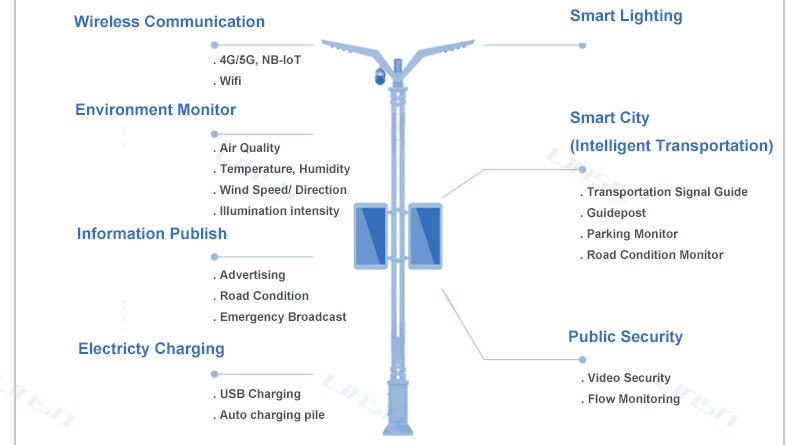Smart Street Poles-Multi-Functional Poles-2024
Smart Street Poles
The idea of smart cities has become increasingly popular in this age of rapidly increasing urbanisation and technological innovation. Innovative solutions are being used to address a variety of urban difficulties as cities work to become more sustainable, efficient, and connected.
Using smart street poles is one such approach that has shown promise as a way to improve urban areas.
Smart street poles are a combination of infrastructure and technology that turn conventional street lighting into data-driven, multipurpose hubs. Energy-efficient LED lighting, environmental sensors, Wi-Fi hotspots, security cameras, electric vehicle charging stations, and even digital signs are just a few of the features that these contemporary poles have. They provide a platform for gathering data in real time and providing services that improve urban environments, making them the foundation of smart city efforts.
Smart street poles provide many advantages to both citizens and municipalities by utilising the power of networked gadgets and data analytics. In addition to enhancing environmental monitoring and facilitating better traffic management, they also increase public safety through the use of video surveillance and emergency response systems and offer insightful information for resource allocation and urban planning.
Follow our Digiknowledge.co.in page for the latest updates about bikes, cars, sports, lifestyle, and many more.
The installation of smart street poles is a crucial step in the direction of developing more sustainable, habitable, and networked urban settings as cities continue to change. The context for examining the revolutionary potential of smart street poles in reshaping future cities is established by this introduction.
What is the smart pole concept? Or, what are the benefits of smart poles?
The integration of many cutting-edge technologies into the standard street lighting infrastructure is known as the “smart pole” idea, which turns traditional light poles into multipurpose, data-driven hubs.
These cutting-edge poles provide a variety of features and services targeted at improving urban connectedness, efficiency, and sustainability, making them essential parts of smart city programmes.
The typical key components of the smart pole concept are as follows:
Energy-efficient LED Lighting: Smart poles frequently have LED lighting systems installed in them. These systems not only illuminate streets and public areas but also use less energy and require less maintenance than more conventional lighting technologies.
Connectivity: Wi-Fi and fibre-optic cables, as well as other wireless and cellular networks, are among the communication infrastructures that smart poles are outfitted with. These systems allow for smooth connectivity and make it easier to install Internet of Things applications.
These poles have a variety of sensors installed in order to track traffic patterns, pedestrian activity, air quality, temperature, humidity, and other pertinent data. Local authorities may monitor, analyse, and make decisions based on the data that these sensors gather in real-time.
High-definition cameras are a common feature of smart poles. By keeping an eye on roads, crosswalks, and public areas, these cameras improve public safety and security.
Digital Signage and Information Displays: When it comes to communicating public announcements, advertisements, traffic updates, or emergency notifications, certain smart poles come equipped with digital signage or information displays.
Additional features: Smart poles may come equipped with audio speakers, emergency call buttons, charging stations for electric vehicles, environmental monitoring devices, or other features based on the demands and priorities of a particular urban area.
The idea of the “smart pole” is an all-encompassing approach to urban infrastructure that uses technology to raise living standards, safety, and efficiency. Smart poles are essential components in the global development of smart cities because they are adaptable platforms for data gathering, communication, and service provision.
What are the benefits of smart poles?
Depending on the particular design, intended use, and needs of the urban setting in which it will be installed, a smart pole’s specs may change. Nonetheless, the following characteristics and attributes are frequently seen in smart poles:
Height and Design: Smart poles usually have a height of 8 to 12 metres (26 to 39 feet), though in some cases, shorter or taller versions might be employed. To go with urban aesthetics, they frequently have a sleek, contemporary appearance.
Lighting: LED lighting systems that use less energy are installed on smart poles, giving streets and public areas a consistent, bright glow. The LED fixtures’ wattage and light output may differ based on the area’s unique lighting needs.
Sensors: A range of sensors can be installed on smart poles to gather information on traffic flow, pedestrian movement, environmental factors (such as temperature, humidity, and air quality), and other pertinent variables. The kind and quantity of sensors can be altered to meet the unique requirements of the city or municipality.
Communication Infrastructure: Smart poles act as hubs for communication, connecting users to cellular networks, Wi-Fi, and other communication technologies. They might also include hardware or antennas integrated into them to enable wireless networking and Internet of Things applications.
Surveillance Cameras: For security and video monitoring, a lot of smart poles have surveillance cameras installed. High resolution, night vision, pan-tilt-zoom, and video analytics capabilities are a few of the qualities that these cameras may have in their specifications.
Power Source: Smart poles usually draw their power from the grid or from other renewable energy sources like solar panels. In order to guarantee continuous functioning during power outages, they could additionally incorporate backup power systems like batteries or generators.
Extra Features: Extra features like digital signs, audio speakers, emergency call buttons, electric vehicle charging stations, and environmental monitoring equipment may be added to smart poles based on the particular needs of the urban environment.
Compatibility and Integration: Smart poles are made to work with current systems and enable communication with other smart city technologies and systems. For smooth integration with different IoT devices and urban management platforms, they could have common communication protocols and interfaces.
How does a smart streetlight work?
In order to identify the presence of people, animals, cars, and weather, smart streetlights employ a network of sensors and cameras. Upon detecting a vehicle, the sensors exchange data and establish communication among themselves. Following management, the data is sent to a secure server, where a web browser dashboard shows it.
What are the disadvantages of smart street lights?
Installation costs, maintenance costs, limited flexibility, interoperability limitations, and energy costs.




